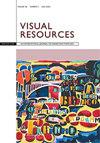Leaving Home: Decoding Art Projects of Female Arab-Palestinian Students
IF 0.1
0 ART
引用次数: 0
Abstract
This article examines projects of female Arab-Palestinian college art students in the Israeli periphery. The projects focus on the students’ living environment, domestic space, and the transition from their childhood home to the new post-marriage house. They experience this transition, which usually also means leaving the familiar environment of their village of origin for another place, as a significant step that involves mixed feelings of self-fulfillment through marriage and the pain of separating from their childhood homes. A qualitative analysis of the projects relying on a methodology of visual interpretation and interviews with the students revealed their ambivalent attitude towards this step. Findings showed that the projects reflect a gendered geography related to the perception of domestic space. The students express an intermediate position of “individualized traditionalism,” compatible with their choice to describe the domestic space as embodying a tension between conservative perceptions of marriage and personal reflections on marriage. It was also found that the projects reflect a “low gaze,” a downward view on the students’ part when they observe the world around them through familiar and concrete objects and limited spaces while practicing art. Their observations emanate from both a state of belonging and an external and critical perspective. Their choice of a realistic-naive painting style and depictions devoid of human figures emphasizes the cultural and gender caution they display when expressing their position, echoing the perceptions of their society.离家:解读阿拉伯裔巴勒斯坦女学生的艺术项目
本文考察了以色列周边地区阿拉伯-巴勒斯坦女大学生的艺术项目。这些项目关注学生的生活环境、家庭空间,以及从童年的家到婚后新房子的过渡。他们经历了这种转变,这通常也意味着离开家乡熟悉的环境去另一个地方,这是一个重要的步骤,涉及到通过婚姻实现自我的复杂感受和与童年家园分离的痛苦。基于视觉解读方法对项目进行的定性分析和对学生的采访揭示了他们对这一步骤的矛盾态度。调查结果表明,这些项目反映了与家庭空间感知相关的性别地理。学生们表达了“个性化传统主义”的中间立场,这与他们将家庭空间描述为体现保守的婚姻观念和个人对婚姻的反思之间的紧张关系的选择相一致。研究还发现,这些项目反映了一种“低凝视”,即学生在练习艺术时通过熟悉的具体物体和有限的空间观察周围世界时的向下视角。他们的观察既来自归属感,也来自外部和批判性的视角。他们选择了现实主义的天真绘画风格和没有人物的描绘,强调了他们在表达自己的立场时所表现出的文化和性别谨慎,呼应了他们社会的看法。
本文章由计算机程序翻译,如有差异,请以英文原文为准。
求助全文
约1分钟内获得全文
求助全文

 求助内容:
求助内容: 应助结果提醒方式:
应助结果提醒方式:


